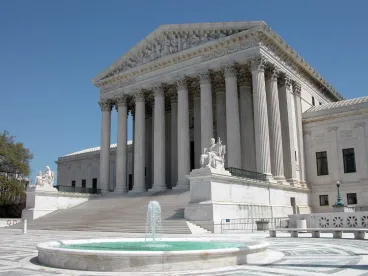On January 10, 2023, justices for the Supreme Court of the United States questioned attorneys for a ready-mix concrete company and the union representing its truck drivers over whether claims to recover the value of the company’s property destroyed as a result of a strike are preempted by the National Labor Relations Act (NLRA). The case, Glacier Northwest, Inc. v. International Brotherhood of Teamsters Local Union No. 174, could provide clarity for employers on how employers can recover the value of property that is destroyed during increasingly contentious labor disputes.
Background
The case involves a ready-mix concrete company that alleged the Teamsters, the union representing the company’s truck drivers, “deliberately” staged a strike after mixing trucks were fully loaded and ready to deliver concrete in order to “destroy” the employer’s property by allowing the concrete to harden in the mixing drums. The company filed a tort suit in state court in Washington to recover the value of the destroyed property. The Washington Supreme Court held that the claims were “impliedly” preempted by the NLRA under the Supreme Court of the United States’ 1959 decision in San Diego Building Trades Council v. Garmon (359 U.S. 236). In that case, the high court held that the National Labor Relations Board (NLRB) has jurisdiction over activity that is “arguably within the compass” of the NLRA, but recognized claims that implicate “interests so deeply rooted in local feeling and responsibility” may not be preempted in the “absence of compelling congressional direction.”
The Teamsters later filed an unfair labor practice charge with the NLRB, alleging that the company filed the lawsuit in retaliation against the truck drivers’ strike. The charge is still pending. Under the Board’s standard, unions are not protected if employees fail to “take reasonable precautions to protect the employer’s plant, equipment, or products from foreseeable imminent danger due to sudden cessation of work.”
Oral Arguments
During oral arguments, counsel for the employer argued that the Supreme Court and the NLRB have “long recognized that the intentional destruction of an employer’s property” is not protected concerted activity under the NLRA. “The more substantial question then is, who gets to decide whether the facts alleged in the complaint are true? The state court or the Board?”
Justices Elena Kagan, Sonia Sotomayor, and Ketanji Brown Jackson seemed poised to side with the union, suggesting that the employer’s claims over its destroyed property implicate the NLRA because the union truck drivers’ alleged action—walking off the job with concrete still in the trucks where it might harden—was “arguably” protected activity as part of a strike. They questioned why the NLRB’s reasonable precautions test is not sufficient to capture the employer’s concerns to stop the intentional destruction of property. Justice Kagan further suggested that the NLRB might have more expertise and “can fit a case like this into a broader map of strike conduct and what’s protected and what’s not.”
However, counsel for the employer argued that it is clear that in a case like the current one—in which an employer alleges that a strike or work stoppage is deliberately timed with the intent to destroy the employer’s property—that such activity is not protected. The concern, he argued, is that when there is an incident that is as “clear” and “egregious as intentional property destruction, it’s important to take that clear category off the table.… [T]he parties need to know the rules of the road.” Counsel for the employer further argued that the state has a significant interest in adjudicating tort disputes.
Counsel for the union argued that the focus should be less on the intent of the actions and more on the actual harm. This is a case where products in the possession of the employer spoiled during a work stoppage, not one in which employees physically destroyed the property, he argued. The cement truck drivers did not set fire to the building nor did they smash equipment, situations that he admitted would not be protected labor activity. But counsel for the employer likened the conduct to workers on a riverboat driving the boat out to the middle of a river and then abandoning ship, leaving it to be destroyed.
Key Takeaways
The case could provide clarity over whether employers may seek to recover damages for property destroyed as a result of union or employee conduct during labor disputes in tort lawsuits under state law. It is always difficult to read the tea leaves of oral arguments, but a ruling for the employer in the case could thus bolster employers’ interests in labor disputes and provide a clear path to recover the value of destroyed property. On the other hand, a ruling that the claims are preempted could open the door for the labor-friendly NLRB under the Biden administration to issue a ruling that such deliberate action by unions or employees to destroy an employer’s property during contentious labor negotiations, as alleged by the employer in this case, is protected activity.






 />i
/>i

